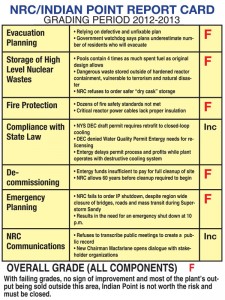Urges hearings on evacuation planning and immediate dry cask storage of dangerous nuclear waste; releases report card giving the NRC failing grades for not addressing critical safety issues at Indian Point
Media Contacts:
Julia Church, Hudson River Sloop Clearwater, julia@clearwater.org, 845-265-8080 x 7112
Tina Posterli, Riverkeeper, tposterli@riverkeeper.org, 516-526-9371
Laura Haight, NYPIRG, laurahaight@gmail.com, 518-588-5481
 HUDSON VALLEY – May 14, 2013— Citizens’ groups and elected officials representing hundreds of thousands of area residents today urged immediate action to improve safety and emergency preparedness at Indian Point in advance of the Nuclear Regulatory Commission’s (NRC) annual assessment meeting for the nuclear plant. The coalition also issued its own collective assessment of Indian Point’s safety record operation over the past year, giving the NRC failing grades for its lax oversight of the aging reactors in 2012, including during Superstorm Sandy. Click here to read the full accessment
HUDSON VALLEY – May 14, 2013— Citizens’ groups and elected officials representing hundreds of thousands of area residents today urged immediate action to improve safety and emergency preparedness at Indian Point in advance of the Nuclear Regulatory Commission’s (NRC) annual assessment meeting for the nuclear plant. The coalition also issued its own collective assessment of Indian Point’s safety record operation over the past year, giving the NRC failing grades for its lax oversight of the aging reactors in 2012, including during Superstorm Sandy. Click here to read the full accessment
The coalition is calling for intensifying, rather than weakening, safety and preparedness measures at Indian Point, specifically urging that hearings take place in Congress and in the New York State Legislature on Indian Point’s emergency plan, and calling on the NRC to require Entergy to move spent nuclear fuel from Indian Point’s two overfilled pools to dry cask storage, in order to reduce the growing risk of a catastrophic fire.
In NRC’s March 4, 2013 letter describing its safety assessment of Indian Point, the agency asserted that “overall, Indian Point operated in a manner that preserved public health and safety and met all cornerstone objectives,” noting it would reduce the number of resident NRC inspectors at the plant from four to three.
In April 2013, the U.S. Government Accountability Office (GAO) reviewed procedures at Indian Point and other plants, and found that regulators have never properly studied “shadow evacuations” — how many people beyond the official 10-mile evacuation zone might decide to evacuate on their own in the event of a major radiological release from a nuclear plant, and how they might impede evacuation from inside the 10-mile zone. This latest report provides yet one more reason why we need public hearings to shine a light on Indian Point emergency planning and preparedness, including what provisions are and are not made for residents, school children, senior citizens, the disabled, and workers inside and outside the 10-mile zone.
The other joint call to action concerns Indian Point’s vulnerable and overfilled fuel pools, which concentrate an enormous amount of radioactivity in close proximity to the most densely populated metropolitan area in the United States. The coalition is urging the NRC to immediately move the dangerous nuclear waste to dry cask storage. Both issues are not being addressed in federal proceedings on relicensing the plant, and demand attention.
The coalition includes, among others, Hudson River Sloop Clearwater, Indian Point Safe Energy Coalition, New York Environmental Law and Justice Project, New York Public Interest Research Group, PHASE, Riverkeeper, Sierra Club Atlantic Chapter, and Westchester Citizens Awareness Network. They were joined in their call to action today by Congressman Eliot Engel (D-NY-16), and Richard Brodsky, a former New York State Assembly member from Westchester, who is now Senior Fellow at Demos.
Congressman Eliot Engel said, “Based on its poor record of safety and the age of the plant, the NRC should deny extending a license to Entergy and close down Indian Point. These reactors would never be approved here were they to be built today, this close to America’s major population and financial center. The plant has 25 million people living within a 50-mile radius. The NRC itself advised Americans in Japan to get 50 miles away from Fukushima when it exploded. But even the U.S. Government Accountability Office in a recently issued report called the emergency evacuation plan for Indian Point inadequate to protect people within the 10-mile evacuation zone. I am the first member of Congress to call for the closure of Indian Point, and I have repeatedly called the evacuation plan impossibility. Indian Point is well past its prime with an increasingly dismal safety record. We have the ability to replace the power it provides. The NRC must not relicense Indian Point. The risks are too great. The safety of our citizens is paramount – it is time to end the nuclear era in our region once and for all.”
“The clear and present danger of Indian Point’s operation and unsafe storage of toxic nuclear waste are well proven, despite the NRC’s annual pep rally assuring us that the plant is safe,”said Paul Gallay, President and Hudson Riverkeeper. “Riverkeeper and our allies are calling on our elected officials and the NRC to take real action to protect the 20 million people living and working in the New York metro area, and at risk from this dangerous facility. We don’t need the power; why take the risk?”
“Of all the safety issues related to the operation of Indian Point, the overcrowded fuel pools may pose the most imminent danger,” said Manna Jo Greene, Clearwater Environmental Action Director. “The main reason Entergy hasn’t moved the older spent fuel rods to dry cask storage is cost avoidance, and they are in essence putting profits before the health and safety of the public. The NRC should require that older fuel rods be moved to dry cask storage as soon as possible.”
“The NRC continues to turn a blind eye to serious safety hazards existing at these aging nuclear reactors sited in the most densely populated area in the country,” said Laura Haight, senior environmental associate with NYPIRG. “Clearly, the lessons of Fukushima have not been learned.”
Gary Shaw, Indian Point Safe Energy Coalition, said: “Entergy and NRC keep pretending that evacuation around Indian Point can be successful, but they never have addressed the weaknesses identified in a study by James Lee Witt, the former head of the Federal Emergency Management Agency; part of which are echoed by the recent GAO report that shadow evacuation is underestimated. Until the Witt Report issues are resolved, any claim that the plan will be effective should simply be dismissed as either incompetence or intentional fabrication.”
“Indian Point is a persistent threat to our high density population in New York and our water supply and must be shut down,” said Annie Wilson, Senior Energy Policy Advisor, New York Environmental Law and Justice Project. “At this time, New York City does not rely on Indian Point’s power. We look forward to a fossil free energy future without the threat of the dangerous, outdated nuclear plant in our backyard.”
###





